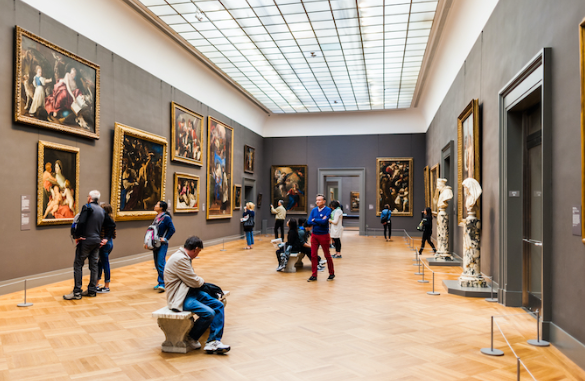
Museums and galleries are far more than brick-and-mortar institutions displaying art; they are the custodians of our cultural heritage, the guardians of human creativity, and the storytellers of our history. Their significance goes beyond mere preservation; they play a pivotal role in both safeguarding art for future generations and sharing it with the world. In this exploration, we delve into the multifaceted role of museums and galleries in preserving and sharing art.
Preserving Art: The Guardians of Cultural Heritage
Museums and galleries are the repositories of our cultural heritage. They safeguard art and artifacts from various time periods, cultures, and artistic movements, ensuring that they remain intact for future generations. Here’s how they fulfill this crucial role:
1. Conservation and Restoration:
Museums invest in conservators and restoration experts who meticulously repair and maintain artworks. They use scientific techniques and materials to ensure that the art is preserved for the long term.
2. Climate Control:
Maintaining a stable environment is essential. Museums and galleries control temperature, humidity, and lighting to prevent deterioration. This meticulous care extends the life of delicate artworks.
3. Documentation and Cataloging:
Every piece in a museum’s collection is documented, cataloged, and tracked. This comprehensive record-keeping helps manage collections and assists in research and provenance investigations.
4. Security Measures:
Museums implement stringent security measures to protect their collections from theft and vandalism. This includes surveillance, alarms, and specialized staff.
5. Research and Scholarship:
Museums conduct research to better understand the art in their collections. This not only contributes to art history but also informs conservation efforts.
6. Education and Training:
Staff members receive training in preservation and conservation techniques to ensure that the art remains in the best possible condition.
Sharing Art: Connecting People to Culture
Museums and galleries are not just treasure troves hidden away; they serve as bridges between art and the public, enabling people to connect with their cultural heritage. Here’s how they facilitate this connection:
1. Exhibitions:
Museums organize exhibitions that bring art to the public. These can be temporary exhibitions, often featuring artworks on loan from other institutions, or permanent collections showcasing the museum’s own holdings.
2. Accessibility:
Museums aim to make art accessible to all. They provide accommodations for individuals with disabilities, offer educational resources, and sometimes host free days to broaden access.
3. Educational Programs:
Museums are dedicated to education. They offer programs for all ages, from children’s art classes to adult lectures and workshops. These programs encourage art appreciation and understanding.
4. Community Engagement:
Museums actively engage with their communities. They often collaborate with local schools, businesses, and organizations to create a more inclusive and interactive cultural experience.
5. Digital Outreach:
In the digital age, museums have extended their reach by providing online access to their collections. Virtual tours, interactive websites, and social media presence allow people from around the world to explore their treasures.
6. Research and Publications:
Museums support scholarship and art research by publishing catalogues, books, and academic journals. These resources contribute to a deeper understanding of art and culture.
7. Cultural Exchange:
Museums foster cultural exchange by lending their artworks to other institutions, both nationally and internationally. These exhibitions facilitate a sharing of culture and ideas.
Interpreting Art: Curating, Context, and Storytelling
The role of museums and galleries goes beyond merely displaying art; it extends to curating exhibitions, providing context, and telling stories that enrich our understanding of art:
1. Curatorial Expertise:
Curators play a crucial role in selecting, organizing, and presenting artworks in a way that informs and engages the public. They develop the narratives that guide exhibitions and collections.
2. Contextualization:
Museums provide the historical, cultural, and artistic context necessary to understand an artwork. This contextualization enriches the viewer’s experience and allows for a deeper connection with the art.
3. Interpretive Materials:
Museums create interpretive materials, such as labels, brochures, and audio guides, to help visitors understand the significance and meaning behind each piece.
4. Exhibition Design:
The design of exhibitions is a deliberate process that considers how the art is presented. This can enhance the viewer’s connection to the artwork.
5. Storytelling:
Museums are storytellers. They narrate the history of a civilization, the life of an artist, or the significance of a movement. This storytelling enriches our understanding and appreciation of art.
Cultural Diversity and Inclusivity: Preserving a Global Heritage
Museums and galleries play a vital role in promoting cultural diversity and inclusivity. They aim to represent a global perspective, ensuring that the art they display reflects the richness and variety of the world’s cultures. This is achieved through:
1. Curation of Diverse Collections:
Museums acquire and exhibit art from diverse cultures and regions, fostering cross-cultural understanding and appreciation.
2. Repatriation Efforts:
Efforts are made to return cultural artifacts to their countries of origin, addressing issues of repatriation and colonialism.
3. Inclusive Representation:
Museums strive to represent marginalized and underrepresented communities and voices in their collections and exhibitions.
4. Educational Initiatives:
Educational programs and outreach efforts aim to engage with communities that might not otherwise have access to cultural institutions.
Conclusion: Museums and Galleries as Guardians and Storytellers
Museums and galleries are the unsung heroes of our cultural heritage. They preserve the art that tells the story of humanity, ensuring that it remains intact for future generations. Simultaneously, they are the storytellers who connect people to that heritage, fostering appreciation, understanding, and empathy.
Their role is multi-faceted, encompassing conservation, education, and curation. They strive to make art accessible, represent a diverse global perspective, and enhance our understanding of the world through the lens of culture and creativity. In this manner, museums and galleries fulfill their mission to not only preserve art but also to share its transformative power with the world.
Leave a Reply